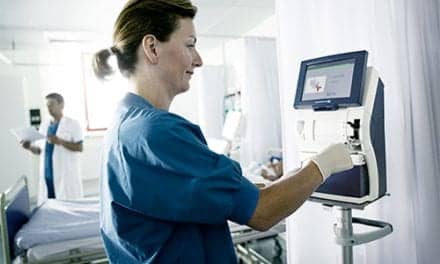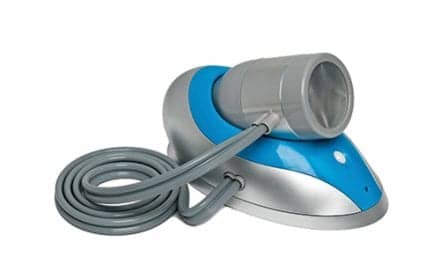It takes a skilled technician to perform accurate spirometric assessment, but the rewards in the form of a useful, powerful tool are worth the training.

A NIOSH employee uses a spirometry machine to get an accurate reading. Courtesy NIOSH/ Kimberly C. Thomas
Spirometry is a powerful tool that is used to detect, follow, and manage patients with a multitude of pulmonary and chest disorders.1 While technologic advances have made spirometry more reliable and increased its availability in mainstream medicine, patient testing remains challenging, because spirometry is effort dependent and requires good cooperation for the patient to produce a quality spirogram or flow-volume loop.2,3
First and foremost, highly trained technicians are required to motivate and secure accurate and repeatable spirometric tests. Their knowledge base must be extensive with regard to pulmonary function testing, lung physiology, recognition of artifacts, poor effort, and other nuances of testing that can lead to an inaccurate interpretation. Those interpreting spirometric tests should be knowledgeable with regard to spirometry, lung physiology/pathophysiology, indices indicating various lung pathophysiologies, and use of normative values for establishing an accurate interpretation and being able to detect artifacts in the tracings as they occur.
Spirometric testing serves many purposes: to aid in respiratory health surveillance programs (occupational screening), to establish the type and degree of pulmonary impairment (obstructive/restrictive, fixed, or reversible), to evaluate lung status when reversible airway disease is suspected or present, to assure the patient that medications are working, to diagnose disease, to detect a change in condition, and to provide feedback to the clinician that a treatment option is optimized for a given patient. Thus, spirometry is a powerful tool that can be utilized in a variety of settings.4,5 Below are representative flow-volume loops representing a normal lung, COPD, fixed extra-thoracic obstruction, cough, restrictive lung disease, and upper airway obstruction.

Spirometry in the Occupational Setting
Protecting the health of employees in the workplace is the primary objective of occupational surveillance programs. If small abnormalities are detected, additional testing should be performed to document the screening suspicion and to thoroughly evaluate the individual’s medical status. Changes in pulmonary function indices can occur within a single day or exposure period. Often these changes may be more subtle: changing slowly over a prolonged period of time, reflecting low dose, long-term exposure. If the cause of the change in pulmonary function is related to occupational exposure, steps should be enacted to modify or eliminate the exposure.
The Cotton Dust Standard found in the Code of Federal Regulations6 gives the National Institute of Occupational Safety and Health (NIOSH) the authority to oversee spirometric training programs in the workplace. Presently, courses designed to train occupational screeners are located throughout the country. Each course director has a background in pulmonary function testing and/or medicine. The Spirometry Training Guide7 can be reviewed by any individual and is required reading for all course participants. Additional material related to occupational health and screening is also available.8
Determining Lung Age
When age is in the regression equation, rearranging the equation to estimate the lung age of an individual can be helpful in examining the impact of disease on the lungs. As an example, suppose you are testing a 42-year-old Caucasian male with a 20 pack year smoking history, and with a height of 70 inches. Using the prediction equation for FEV1 from Crapo et al,28 we have FEV1 males = 0.0414H – 0.0224A – 2.190 as our prediction equation. Using the data from above, we calculate a predicted FEV1 = 4.15 L. Now we perform spirometry on our subject and the actual measured value is 2.15 L or 52% of predicted, clearly demonstrating significant impairment.
However, it may be more informative to the patient if we could tell him how old his lungs would appear based on the measured value if his lungs were actually at 100% of predicted for normal aging. By rearranging the equation, we can derive the lung age his actual pulmonary function value would indicate if he would have aged normally. Thus, by conducting a simple algebraic rearrangement of the original equation, we calculate a lung age of 124 years where lung age = ((FEV1 – 0.0414H + 2.19)/ – 0.0244), which is a simple algebraic rearrangement of the original equation. Now when you compare his chronological age of 42 years to that of 124 for lung age, the message becomes clearer.
An essential part to any screening program is the sequence of testing used in the workplace.9 The decision for the timing of spirometric screening should be based on exposure characteristics, a thorough review of the literature and standards governing screening for a potential worksite hazard, complaints from workers, and a consistent long-term pattern for longitudinal screening (equal days spacing or based on dosimeter monitoring). If acute changes are suspected, then before and after shift testing should be performed. For those with complaints, more frequent testing should be enacted.
Because small changes in pulmonary function can occur over a protracted period of time, the Spirometry Longitudinal Data Analysis (SPIROLA) software10 was implemented. This is an easy-to-use visual and quantitative software application designed to assist the screener in monitoring and interpreting computerized spirometry data. However, each tool cited above is just that—a tool to assist a knowledgeable individual in unraveling what may be a significant clinical/occupational finding or a number of other nonclinical possibilities (artifact, poor quality controls of spirometric testing devices and methods, or intentional manipulation of data).
Detecting and Following Disease With Spirometry
Spirometry is an essential tool for evaluating and quantifying pulmonary function in normal individuals and those with known disease. Unlike some other diagnostic tools available to the clinician, spirometry focuses on evaluating the physiology of the lung and thorax. This is achieved by visualizing a flow-volume loop or reviewing a time-based tracing (spirogram).11 While technology has advanced the utility of spirometric devices, acquisition of quality data resides in the hands of well-trained technicians who understand and recognize pathological findings and quality effort tracings versus less optimal data derived from inadequate effort, poor calibration, faulty equipment, or artifact. Likewise, interpretation of the data should be carefully approached and the appropriate use of normative data carefully considered. Many papers have reviewed the procedures for spirometric testing and interpretation, as well as what constitutes a reliable spirometer.12-15 What we will touch on is the need for spirometric testing in the clinical setting.
Chronic obstructive pulmonary disease (COPD) is a serious chronic disease process in the lung, which may result from long-term exposure to cigarette smoke, specific occupational exposures, exposure to combustion gases and contaminants, or genetic predisposition due to alpha-1 antitrypsin deficiency.16,17 The spirometric hallmark of COPD is airway obstruction as indicated by FEV1/FVC <70%. On the other hand, restrictive lung diseases may be idiopathic or can occur from exposure to numerous agents, infection, growths, neurological conditions, or trauma. The spirometric hallmark of restrictive disease is the loss of ventilatable lung volume as indicated by a reduction in FVC or total lung capacity. Both conditions require an accurate and thorough evaluation, as well as other confirmatory tests. Importantly, spirometric testing is essential in establishing the type and severity of the disease process encountered.18,19
Spirometry performed over time can establish the longitudinal course of the disease and may be useful in establishing a quality treatment program, providing the patient with deeper understanding and ability to cope. As an aid to formal spirometric testing, many handheld screening devices can be used by patients to track their disease progression.15 Routinely used in patients with asthma, these monitoring devices typically use peak flow or the forced expiratory volume in one second (FEV1) as the monitoring variable.20,21 Some of the modern electronic devices can measure several indices and store the information for a month or longer.22 Some devices transfer information to the clinician via the telephone or Internet. The purpose of these devices is not to diagnose, rather to regularly monitor for change in condition or to alert as to the need to initiate a treatment plan. For example, the clinician can give an asthmatic patient a target score; when the peak expiratory flow falls below that target score, a prescribed rapid action plan is then initiated. This may be followed for other lung processes, as well.

When any risk factor is present, it is essential that a baseline spirometry be performed.23 While the initial spirometry will be compared and contrasted to normative data based on age, gender, race, etc, follow-up tests will then be compared against the first. For example, a 45-year-old male smoker is undergoing a regular physical examination. Because he is a smoker, a baseline spirometry may be recommended. When reviewing the results, it is noted that many of the indices such as the FEV1 and FVC exceed the 100% of predicted for that individual’s normative comparison. Now 10 years later, with continued smoking, this same individual has lost 30%+ of his lung function and yet remains in the normal category when compared to normative data. Thus, the importance of obtaining an early baseline is established, given that there is a documented 30%+ decrement in lung function that would not have been appreciated if the baseline testing was not performed. This is also very meaningful for individuals who have genetically small lungs and would have baseline pulmonary function at the low end of normal. In this case, if their lung function declines a very modest amount, they may then be classified as abnormal based on predicted values and, thus, receive more frequent costly medical surveillance and/or treatment that may not be warranted.
Spirometry in Disease Management
Some disease management methodologies are designed to be lifetime chronic care interventions. The disease management diagram on the ATS-ERS COPD Guidelines24 suggests that the disease can be tracked and interventions may be initiated based on the clinical pattern of the disease. At the same time, the disease can be staged by severity as determined by spirometry—particularly the FEV1.18 Neither approach is comprehensive given the fact that COPD is a multifactorial illness that is not capable of finite characterization solely by either symptoms, or airway obstruction, or hyperinflation.
Initial spirometry helps to establish the diagnosis, whereas follow-up spirometry tracks the clinical course of the disease. As the FEV1 worsens, the patient is more likely to progress to the exacerbation stage. As the patient exacerbates more frequently, the disease progresses more rapidly as indicated by the deterioration of FEV1 (see Figure).
At this point, interventions that reduce the frequency of exacerbations would be advisable along with rapid action plans at the first sign of exacerbation onset. Hence, regular spirometry is a logical component of the chronic care management plan.
Predicted Values
Spirometric regression equations are commonly used to predict an disease-free individual’s values based on gender, age, height, and other dependent variables. Typically, the predicted value is divided into the measured value for the subject and a percent predicted (%Pred) value is rendered. The actual values have little meaning. However %Pred values are generated, these data become essential in defining the type and severity of disease (see Table).
For a comprehensive understanding of using %Pred values, refer to Lung Function Testing: Selection of Reference Values and Interpretation.26,27 While %Pred values have good scientific validity and are routinely used in clinical medicine, the average person may have some difficulty in understanding their true meaning. This is where physicians and disease managers can present the information in such a way that individuals can better grasp the true meaning of the results.
Summary
Spirometric testing is a valuable tool for clinical assessment of physiologic functioning of the lung and the respiratory apparatus. The greatest utility occurs when highly trained technicians perform testing in a controlled environment; they immediately identify good effort and recognize poor effort, artifact, and/or instrumentation problems. Additionally, the clinician should be specifically trained in reviewing and interpreting the results in light of other clinical and laboratory findings and must be able to question the validity of the tracings. The utility of assessing physiologic function using spirometry in the clinical setting is firmly established and has an important role in occupational settings.
Spirometry also serves to provide ongoing surveillance in nonoccupational settings such as asthma and/or reactive airway disease. Recently, it has gained additional awareness and use when part of an interventional and/or disease management strategy. Newer technologies provide the ability to store, compare and trend spirometric results, and be incorporated into formal clinical and experimental protocols. Additional technological innovations will further expand the role of spirometry and its utility in evaluating lung function and guiding treatment in multiple settings. RT
Rick Carter, PhD, MBA, is professor, exercise sciences; Brittnee Rodriguez is a fourth year premed student; Lamar University, Beaumont, Tex. Brian Tiep, MD, is director of pulmonary rehabilitation, City of Hope National Medical Center, Duarte, Calif. Rebecca Tiep, BS, is research assistant, Respiratory Disease Management Institute, Pomona, Calif. For further information, contact [email protected].
_______________________________________________________________________________
References
-
Doherty DE, Lawrence G, Nett LM, Petty TL. The National Lung Health Education Program (NLHEP). Proc Am Thorac Soc. 2006;3:545.
-
Cooper CB. Assessment of pulmonary function in COPD. Semin Respir Crit Care Med. 2005;26:246-52.
-
Enright P, Lebowitz M, Cockcroft DW. Physiologic measures: pulmonary function tests. Am J Respir Crit Care Med. 1994;149(2 Pt 2):s918.
-
Pierson DJ. Translating new understanding into better care for the patient with chronic obstructive pulmonary disease. Respir Care. 2004;491:99-109.
-
Fishman AF. Pulmonary Diseases and Disorders. New York: McGraw Hill; 1991.
-
CFR. Cotton Dust. Available at: cfr.vlex.com/vid/1910-cotton-dust-19686797. Accessed August 30, 2011.
-
NIOSH Spirometry Training Guide. Available at: /www.cdc.gov/niosh/docs/2004-154c/. Accessed August 30, 2011.
-
Occupational Safety and Health Administration. OSH QuickTakes. Available at: osha.gov/pls/oshaweb/searchresults.relevance?p_text=cotton%20dust%20standard&p_status=CURRENT&p_title=. Accessed August 30, 2011.
-
Viegi G, Scognamiglio A, Baldacci S, Pitselli F, Carrozi L. Epidemiology of chronic obstructive pulmonary disease (COPD). Respiration. 2001;681:4-19.
-
Centers for Disease Control and Prevention. Workplace Safety & Health Tips. Available at: www.cdc.gov/niosh/topics/spirometry/spirola.html. Accessed August 30, 2011.
-
Bass H. The flow volume loop: normal standards and abnormalities in chronic obstructive pulmonary disease. Chest. 1973;63:171-6.
-
Cherniack RM, Raber MB. Normal standards for ventilatory function using an automated wedge spirometer. Am Rev Respir Dis. 1972;106:38-46.
-
Vaida P, Bargeton D, Guenard H. BTPS calibration of heated Fleisch Pneumotachometer. Bull Eur Physiopathol Respir. 1983;19:635-40.
-
Nelson SB, Gardner RM, Crapo RO, Jensen RL. Performance evaluation of contemporary spirometers. Chest. 1990;97:288-97.
-
Rebuck DA, Hanania NA, D’Urzo AD, Chapman KR. The accuracy of handheld portable spirometers. Chest. 1996;190:152-7.
-
Carter R, Tiep BL, Tiep R. The emerging chronic obstructive pulmonary disease epidemic: clinical impact, economic burden, and opportunities for disease management. Disease Management & Health Outcomes. 2009;16:275-84.
-
Carter R, Tiep BL, Tiep R. Patients with Alpha-1 Antrypsin Deficiency. disease management considerations. Disease Management & Health Outcomes. 2009;16:345-51.
-
ERS-ATS Task Force. ERS-ATS Standards for the Diagnosis and Management of Patients with COPD. European Respiratory Society 2004. Available at: www.ers-education.org/ersMade/webcasts/copd/files/main/index.html. Accessed August 30, 2011.
-
Brake A. ATS’ standardization of spirometry 1994 update takes into account new technologies and RCPs’ role. RT: the Journal for Respiratory Care Practitioners. February/March 1996:85-8.
-
Gibson PG. Monitoring the patient with asthma: an evidence-based approach. J Allergy Clin Immunol. 2000;106(1 Pt 1):17-26.
-
Mansell A, Walders N, Wamboldt M, et al. Effect of body mass index on response to methacholine bronchial provocation in health and asthmatic adolescents. Pediatr Pulmonol. 2006;41:434-40.
-
Klein RB, Fritz GK, Yeung A, McQuaid EL, Mansell A. Spirometric patterns in childhood asthma: peak flow compared with other indices. Pediatr Pulmonol. 1995;20:372-9.
-
Ferguson GT, Enright PL, Buist AS, et al. Office spirometry for lung health assessment in adults: a consensus statement from the National Lung Health Education Program. Chest. 2000;117:1146-61.
-
American Thoracic Society/European Respiratory Society. Standards for the Diagnosis and Management of Patients with COPD. Available at: www.thoracic.org/clinical/copd-guidelines/resources/copddoc.pdf. Accessed August 30, 2011.
-
Pellegrino R, Viegi G, Brusasco V, et al. Interpretative strategies for lung function tests. Eur Respir J. 2005;265:948-68.
-
Lung function testing: selection of reference values and interpretative strategies. American Thoracic Society. Am Rev Respir Dis. 1991;144:1202-18.
-
Rejeski WJ, Foley KO, Woodard CM, Zaccaro DJ, Berry MJ. Evaluating and understanding performance testing in COPD patients. J Cardiopulm Rehabil. 2000;20:79-88.
-
Crapo RO, Morris AH, Gardner RM. Reference spirometric values using techniques and equipment that meet ATS recommendations. Am Rev Respir Dis. 1981;123:659-64.










Flow should be on the y-axis and volume on the x-axis for the Flow-Volume loops. The current loops are incorrect.
They are ‘Flow-Volume’ not ‘Volume-Flow’ loops.